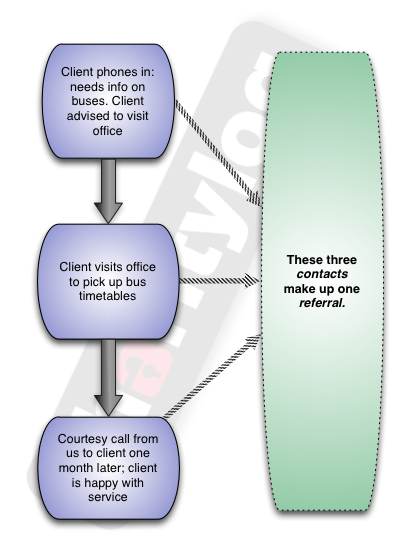Template:Rac1overview
Recording contacts is really what Charitylog is all about. We want to help you get the numbers and statistics you need for funders. Mainly, organisations need to count the interactions they have with their clients.
Simply making staff count their interactions is doomed to failure, because it's an extra job. That counting has to be done by someone, but it doesn't tend to work if you just ask staff to count things. With Charitylog, we give your organisation an extra bonus: a comprehensive way of managing your work, passing work from one person to another (no more emails, telephone messages or scraps of paper!) and recording case files.
This chapter will mainly focus on the work management side of recording contacts. The counting is being done in the background, and we'll look at it in the Reports chapter.
Contents of this chapter:
Recording Contacts 1: Overview (you are here)
Recording Contacts 2: Finding or creating clients
Recording Contacts 3: Recording contacts with clients
Recording Contacts 4: Anonymous contacts
Recording Contacts 5: Contacts with non-clients
The chain of actions
So what exactly do we mean by "recording contacts"? Well, let's look at an example; imagine that your organisation helps people apply for benefits. This flow chart shows a (simplified!!) piece of work that might be done with a client that wants to access a certain benefit. If we were to describe the whole piece of work, we might say the following:
"Mrs Jones phoned in for information about this benefit. We decided she might be eligible and booked a time for her to come into the office. After speaking to her in person it seemed that there was a good chance of her obtaining the benefit. She took the relevant forms home, filled them in and returned them. We sent them to the relevant person at the Council, and after a few weeks, her benefit was awarded. We conducted a follow-up interview three months later and she was very happy with our service."
Without a system like Charitylog, the information here might be stored any number of ways, but if we use Charitylog to manage our work, we get the following benefits:
- On first contact with the client, we can see straight away if they've had involvement with us before, which makes us look really professional!
- We can manage our own workload and set reminders for ourselves to do the next action, at the same time as recording details of the current action.
- We can easily assign work to our co-workers, and it will appear in their upcoming work immediately; no need for email messages or paper reminders.
And in the background, Charitylog is logging all this. From this example chain of actions, we could run reports that would tell us:
- How long it took to complete the chain of actions
- How many actions like this we've had in a given time period
- How many successful benefit applications we've done in the last quarter, which member of staff they were obtained by, how many weren't successful, and why
- How many clients were happy with our service
- Plus much more
And best of all, we will have completely eliminated the counting that staff have to do at the end of each quarter/year. Providing we use Charitylog properly, it will all be done automatically.
